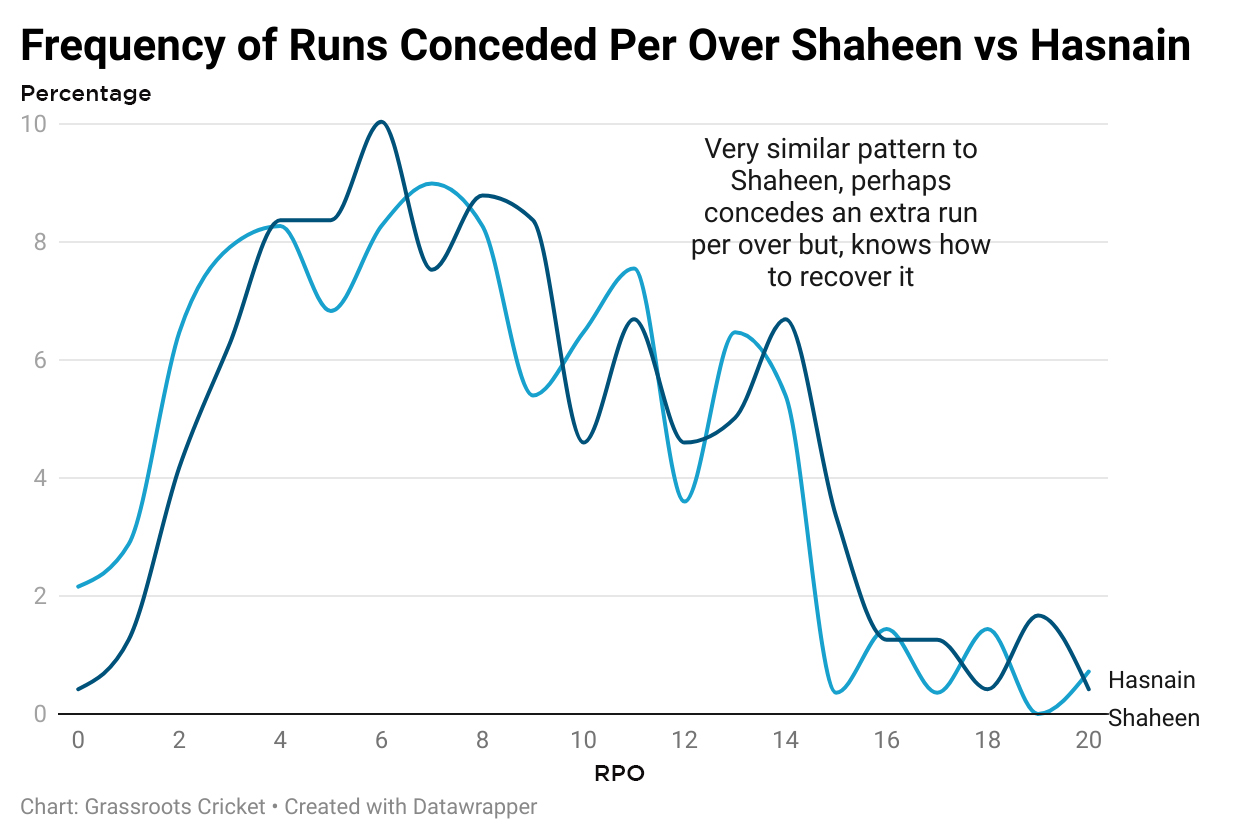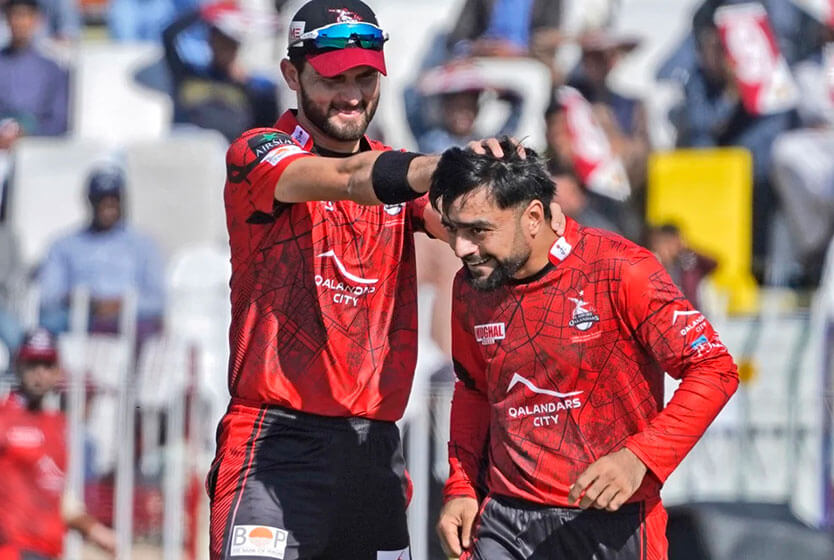
Understanding Mohammad Hasnain: Jack of all Phases, Master of None
Despite being just 21, the speedsteer has more than 2 years of T20 experience. What does he bring to a bowling attack?
Mohammad Hasnain has had a pretty standard rise to recognition for a young Pakistani speedster. At the start of 2019, he wasn’t with any PSL team, and not many knew about him. Halfway through the year, he first got selected as a replacement player for Quetta, then impressed enough to be a key figure in his team’s run to the title, including bagging a Man of the Match award in the final. All this culminated in a call-up to Pakistan’s squad for the ODI World Cup.
He would then, infamously, not play a single game at the World Cup. Further along in the year, he would pick up a hat trick vs. Sri Lanka in a series nobody wants to remember. The whirlwind of a year ended with him getting carted all around the place by a ruthless Aaron Finch and David Warner.
And yet, people didn’t know what to make of him. He had pace; everyone could see that. But what was his bowling approach? Was he a new ball option or a 3rd seamer? Could he bowl at the death?
It is difficult to get a proper gauge of a player in one season of PSL and a game here or there with the national team when the team management remembered he existed.
Two years down the line, Hasnain has had to grow up fast. The PSL team in which he was used carefully in his first season now required him to become the spearhead of their attack. In the first year, he responded brilliantly, topping the wicket-taker charts in the group stages. The second year, he found himself in an even more dysfunctional attack on unforgiving wickets. Nevertheless, he still finished as their highest wicket-taker for the season.
Phase Comparison
Hasnain finds himself competing with three other fast bowlers for a T20 World Cup berth. Shahnawaz Dahani and Mohammad Wasim had much better PSL 2021s than him, while Haris Rauf seems to be the man currently in possession of the third seamer spot in the XI.
It is unlikely that Pakistan will play more than three seamers in a T20 World Cup game, with the UAE pitches already showing signs of wear and tear in the IPL matches. As of now, Pakistan’s bowling plans stand as Shaheen Shah Afridi and a left-arm spinner or Mohammad Hafeez with the new ball, followed by Hasan Ali and Shadab Khan in the middle with Hasan and Shaheen to finish off. All they need of their third seamer is to fill in the blanks.
They may at times require their third seamer to bowl in the Powerplay; perhaps there is movement in the air, or the batsman batting is vulnerable to high-end pace. If they are unable to bowl their third pacer in the Powerplay, they may have to over-bowl one of Hasan or Shaheen, which could have lasting implications further on in the game.
Powerplay Comparison (T20s Since 2019)
| Bowler | Overs | Wkts | Avg | SR | Econ | % Overs |
| Haris Rauf | 75 | 21 | 33.0 | 21.4 | 9.23 | 26.9% |
| Mohammad Hasnain | 85 | 21 | 32.9 | 24.3 | 8.12 | 35.5% |
| Mohammad Wasim | 18.2 | 3 | 45.7 | 36.7 | 7.47 | 32.5% |
| Shahnawaz Dahani | 18 | 5 | 24.4 | 21.6 | 6.78 | 37.2% |
Haris is a well-known liability in the Powerplay. With an economy of over 9 RPO, it doesn’t matter if his strike rate is the lowest of the four. Most of the time, bowling him in the Powerplay isn’t worth the risk.
Mohammad Wasim showed promise with the new ball in the few games he played. However, while he keeps a lid on the scoring, he doesn’t take wickets as often as you would expect of your third seamer.
So Haris is too expensive, and Wasim isn’t threatening enough, so just like Goldilocks, we now come to option number three, which looks just right. Shahnawaz Dahani has the best economy rate of the lot and the second-best strike rate. However, his total Powerplay wickets are just five, pretty par for the course because he didn’t come onto the radar for national selection before this year. However, it does mean that you will be trusting only five wickets as your case for starting with him in the T20 World Cup.
Option four is Mohammad Hasnain; his average isn’t incredible, his strike rate is good, the economy is decent. Thus at first glance, you have a distinctly average option. But his overall numbers don’t do justice to the improvement in his new ball bowling over the last two years.
From 2019 to 2019, he brought his Powerplay economy down from 9 to 7.8. With more control, from 2020 to 2021, he brought his Powerplay strike rate from 29.0 to 22.5 while also bringing the economy down to 7.73. All this means that he’s basically an above-average Powerplay option and can be trusted to deliver there when required.
Middle Overs Comparison (T20s Since 2019)
| Bowler | Overs | Wkts | Avg | SR | Econ | % Overs |
| Haris Rauf | 112.5 | 31 | 28.2 | 21.8 | 7.75 | 40.5% |
| Mohammad Hasnain | 90 | 28 | 25.0 | 19.3 | 7.79 | 37.6% |
| Mohammad Wasim | 25 | 6 | 39.5 | 25.0 | 9.48 | 44.4% |
| Shahnawaz Dahani | 18.2 | 11 | 13.3 | 10.0 | 7.96 | 37.9% |
Moving on to the middle overs, Dahani once again stands out. His style of hit-the-deck bowling is perfectly suited to T20’s middle overs. Mohammad Wasim, however, seems to be lost for ideas without a set plan and has by far the worst economy rate of the four. Meanwhile, Haris has the most middle over wickets with a decent average and economy.
Mohammad Hasnain again proves to be an above-average option in the phase where the fourth seamer will most likely bowl at least two overs. These are numbers from not one PSL season but stints with the national team, multiple seasons of PSL, and other league cricket. He also has a hit-the-deck approach to bowling, though not as extreme as Dahani’s. Pakistan would like a hit-the-deck bowler as their third seamer as it’s a different form of attack from Shaheen’s predominantly full bowling and Hasan’s cutters.
Teams rarely reserve four overs of the premier fast bowlers’ overs for the death. If Pakistan were adamant about using only Hasan and Shaheen’s two overs during most of the innings to make sure the death is taken care of, it would hint at inflexibility that opposition teams would look to take advantage of. The third seamer will have to bowl at least one over at the death, and this is where Dahani’s bid for a starting berth hits a roadblock.
Death Overs Comparison (T20s Since 2019)
| Bowler | Overs | Wkts | Avg | SR | Econ | % Overs |
| Haris Rauf | 90.5 | 56 | 14.2 | 9.7 | 8.73 | 32.6% |
| Mohammad Hasnain | 62.5 | 34 | 18.5 | 11.1 | 9.99 | 26.9% |
| Mohammad Wasim | 13 | 9 | 12.0 | 8.7 | 8.31 | 23.1% |
| Shahnawaz Dahani | 12 | 8 | 16.9 | 9.0 | 11.25 | 24.8% |
Haris is, far and away, the best death bowling option. Wasim’s economy is impressive, but it’s off a sample size of only 12 overs compared to Haris’ 90+. While Hasnain again manages to be distinctly average, he also has quite a bit of experience of bowling at the death, as Quetta and Sindh often required their spearhead to bowl two overs at the death.
Hasnain’s T20I death economy is actually much better – 8.45. This may be down to him not being required to take senior death bowling duties in the national team as he often found himself playing with better death bowlers such as Shaheen, Hasan, and Rauf.
If Pakistan step onto the field with Hasnain as their third seamer, they will need not worry about when and where to bowl him. Dahani and Rauf, with the right plans and management, may be able to outperform him, but that would require Pakistan to be inflexible at certain times or willing to take a risk in World Cup.
For example, if Moeen Ali walks out at No.3 in the 4th over in the semi-final, Pakistan know they have to bounce him out before he gets to the spin overs because there he will lay waste. Now, they can bowl one Hasan over but for the second Powerplay over, they will either have to gamble with giving Haris a Powerplay over or giving Shaheen an extra over and hence having only one over from their best pacer left for the rest of the innings. Similar scenario with Dahani where Shaheen or Hasan bowl the extra over to get a wicket, resulting in Dahani with a death economy of 11+ needing to bowl a death over.
Over Recovery
Hassan Cheema has often mentioned that young T20 bowlers take a while to learn how to “recover an over” after an early boundary. He gave the example of Wasim, who he says will either bowl a 6-8 run over or a 14 run over, nothing in between. Using this idea, we compared the four young speedsters to the best T20 pacer in Pakistan – Shaheen Shah Afridi.
With Wasim, as Cheema predicted, there are two peaks. One at 5-6 runs and then at 14. While Shaheen gradually builds to a crescendo at 7 and then slowly peters out, Wasim shows a greater tendency to go for big overs.
Dahani is interestingly different from most others, as his peak isn’t at 6-8 but actually 10. This may be down to the extra pace and bounce he generates of the pitch, which results in batsman finding it easier to use that pace to hit the boundary that transforms the over from a 4-6 run one to a 10 one.
Haris, meanwhile, follows the same pattern as Shaheen but as Pakistan fans will tell you, has a greater tendancy of conceding big overs as seen by his line being higher than that of Shaheen in the 15-20 run phase.
Interestingly, despite being known as someone with a tendency to leak runs, Hasnain’s graph pretty much follows Shaheen’s graph to the T in terms of pattern. His chart seems to be one run ahead of Shaheen, shifting towards the right as if it has undergone the Bohr effect.
If Babar can use Dahani or Rauf correctly, they could elevate Pakistan’s attack to the next level with their superior skills in certain phases of the game. However, Hasnain provides flexibility and the experience of playing high-level T20 cricket for more than two years, often as his team’s spearhead. None of them are the wrong option; it just depends on how Pakistan and Babar want to approach the game.













Leave a Reply